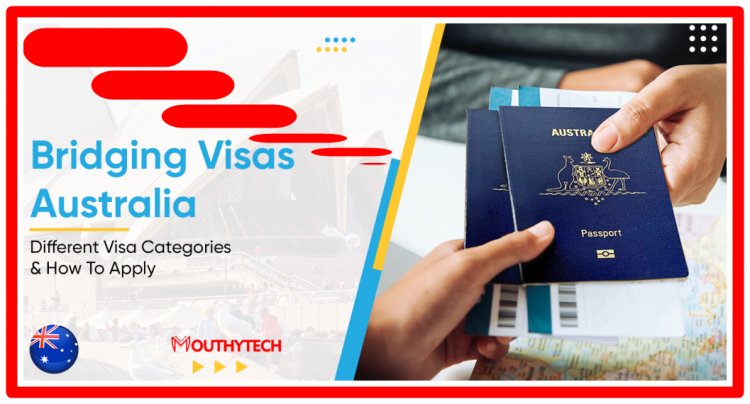How to Apply for an Australia Bridging Visa in Canada
If you are an Australian citizen who has been granted permission to live in Canada on a long-term basis, and if you want to meet the requirements of Australia’s Special Category Visa (a visa that allows eligible citizens of certain countries to live permanently in Australia), you may be able to apply for an Australia Bridging Visa in Canada. The Australia Bridging Visa is valid for one year from the date of issue. After your first year in Canada has ended, you can continue living there as a permanent resident by applying for a Canada Permanent Resident Card (PR Card). This article will help answer some of the most commonly asked questions about Australia Bridging Visas in Canada

How to Apply for an Australia Bridging Visa in Canada Australia is a popular destination for many Canadians. In addition to being home to some of the world’s most beautiful natural landscapes and friendly people, Australia’s immigration policies are also extremely welcoming. Suppose you’re currently living in Canada or plan on doing so in the future. In that case, it may make sense for you to apply for an Australia Bridging Visa instead of remaining in the country indefinitely. Australia offers several types of bridging visas to eligible applicants.
These include Bridging Aussie – a temporary visa that allows qualified visitors from another country to spend up to 6 months in Australia as a visitor (and not as a permanent resident). It would help if you traveled back to your country of origin every six months to renew your visa. However, after restoring once, you will no longer need a letter from your home country vouching for how frequently you will be returning there (instead, you need only prove that your passport was valid when you applied for your visa).
Bridging Aussie can only be issued for one type of purpose: visiting family members who are citizens or residents of Australia and need someone who lives outside their country to help care for them. At the same time, they are there (in other words: if your parent or child lives in Australia without any relatives living abroad, you won’t be able to get this visa).
What is an Australia Bridging Visa?
Australia is one of the most popular places in the world to visit. With over 22 million visitors per year, it’s no wonder that so many Canadians wish to travel there. If you have the funds and time to explore this great country, you may want to you could stay longer. A bridging visa allows you to stay in Australia temporarily. Once you have a bridging visa, you can travel to your home country ( Canada ), then return to Australia and apply for a permanent resident visa. Although this option is not permanent, it allows you to stay in Australia for longer before returning to Canada and potentially missing the chance to re-join your family.
How to Apply for an Australia Bridging Visa in Canada
If you’re currently in Canada, then you can apply for an Australia Bridging Visa at a nearby Australian embassy or consulate. For example, you can apply for an Australia Bridging Visa at the Australian High Commission in Ottawa, Ontario. Before you apply, you will need to schedule an appointment with the Australian Embassy or Consulate to ensure you have enough time to complete the application process. You should also bring a valid passport, tickets showing your return date, and enough money to cover the cost of any medical tests that are required.
What Are the Bridging Visa Types for Australia?
The following are the types of Australia bridging visas:
Bridging Visa A (010).
This bridging visa is issued to those previously held or currently holding another substantive visa. This visa is free of charge and must be submitted the same way the substantive access was (either online or via a paper application). Usually, this visa is issued without working rights, but if you can demonstrate that you need to work, you can re-apply for another BVA with some work limitations. A BVA doesn’t allow you to travel outside Australia.
Bridging Visa B (020).
You are eligible for a bridging visa B if you have or you had previously another substantive Australia visa and you need to travel. In contrast, your new visa application is processed. You must show that you have very compelling reasons why you must leave Australia to get this visa. A BVB can also be granted if you have a BVA and want to travel.
Bridging Visa C (030).
A bridging visa C may be issued to you if you didn’t have or don’t have a substantive visa but have applied for one. This visa will grant you legal status temporarily until your application is finished being reviewed by the Department. You cannot switch from a BVC to a BVB, which means you are not allowed to leave Australia while you have a valid BVC.
Bridging Visa E (050, 051).
This visa allows you to stay in Australia as you prepare your travel arrangements if your substantive visa expires. Subclass 051 is granted only to applicants who have applied for a protection visa.
Document Checklist for an Australia Bridging Visa
These are the public documents you need to present for your bridging visa application:
- You must have a copy of your passport bio page or any other identification document.
- You are required to show that you are of good character.
- You may be required to submit your fingerprints after you apply for the visa.
- Depending on who helps you with your application, you can submit this form for an appointed recipient or this form for a migration agent.
- Parental consent forms (for a BVB).
- Proof of compelling reasons for travel (for a BVB).
Preparing Your Documents
When you apply for a bridging visa, your documents should be in English, or you can submit translated versions of the original documents. Your documents have to be solved by the National Accreditation Authority for Translators and Interpreters.
If you are applying for the visa online, you must submit scanned copies of the documents or photocopies, but make sure the scans and photocopies are clear and visible.
Bridging Visa Application Process
You can apply either on paper or online for your bridging visa. The Department prefers you submit online applications so that you can apply for a ticket via ImmiAccount.
Please keep in mind that you can only apply on paper for a bridging visa 051.
When Should I Apply for a Bridging Visa?
- You need to apply for a bridging visa if:
- You are applying for an appeal of a denial decision on your visa application.
- You are applying for a judicial review of a visa application.
- Your current visa has expired, and you are still in Australia without a valid visa.
- You hold a bridging visa A, and you need to travel.
- You hold either a bridging A or C that doesn’t allow you to work and need a visa without work limitations.
After You Apply for Your Bridging Visa
You will be notified when the Department of Immigration receives your application, and once your visa is approved, the Department will send you the visa grant letter.
Are Bridging Visas Long-Term Visas?
No, bridging visas are only available for a short period. These visas serve only one specific purpose; to grant you legal status until you have a long-term Australia visa or leave the country.
Can I Stay Longer With a Bridging Visa?
You cannot stay longer with a bridging visa. Generally speaking, once your bridging visa is no longer valid, you have to leave Australia unless you manage to apply for another bridging visa and you are granted access.
If Your Bridging Visa Was Granted on or After November 19, 2016
You have 35 days until your bridging visa expires after:
The Immigration Office denied your visa application, or the AAT (Australia Appeals Tribunal) denied your review request.
It’s determined that you cannot apply for an appeal at the AAT.
You send a cancellation notice for your substantive visa application or cancellation of your review request at the AAT.
If your Bridging Visa Was Granted Before November 19, 2016
- Your bridging visa will become invalid after 28 days if:
- Your substantial visa application was denied.
- The Immigration Office concluded that your visa application is invalid.
- You withdrew your application.
- The AAT agrees with the denial decision by the Immigration Office on your visa application.
- The AAT concludes that they have no decision power over your visa application.
- You withdraw your application for an appeal against the decision.
- The judicial review agrees with the denial decision.
Benefits of a Bridging Visa for Canadians in Australia
- You will be able to travel to Australia and back to Canada after spending three months in Australia.
- You will not need to complete the application process for a permanent resident visa (otherwise known as a “green card”).
- You will be able to travel to and work in Australia.
Should you apply for an Australia Bridging Visa?
Suppose you’re a Canadian citizen and would like to visit Australia for a vacation or an extended break for an education program. In that case, a bridging visa may be a good option for you. However, it may not make sense for most people to get a bridging visa when they could stay in Canada and apply for a Canada Permanent Resident visa later. A permanent resident visa allows you to live and work in Australia indefinitely. You will also be eligible for Australian citizenship and all the rights and responsibilities that come with that. Therefore, getting a permanent resident visa is usually the best option for most Canadians.
Disadvantages of a Bridging Visa for Canadians in Australia
- You will have to travel back to Canada every six months and apply for a new visa.
- You will not be able to apply for Australian citizenship.
- You will only be able to stay in Australia for up to 3 months.
Final Words
If you would like to visit Australia, it may make sense to apply for an Australia Bridging Visa instead of remaining in the country indefinitely. You can apply for an Australia Bridging Visa at an Australian embassy or consulate. You will need to schedule an appointment to make sure you have enough time to complete the application process. You can stay in Australia for up to 3 months before returning to Canada and applying for a new bridging visa.
What's Your Reaction?




















